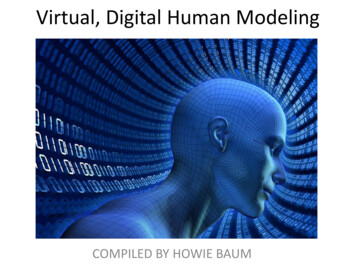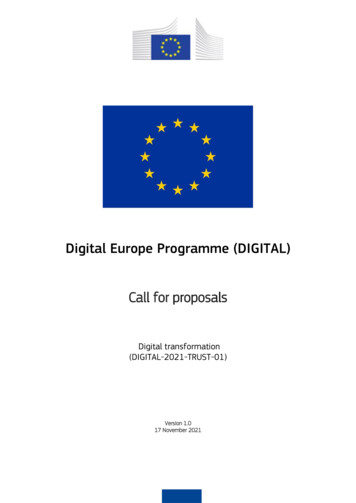
Transcription
Virtual, Digital Human ModelingCOMPILED BY HOWIE BAUM
INTRODUCTIONThree-dimensional manikins are also known as Digital Human Models(DHM).These are software representations of humans that enable designers tovisualize the effectiveness of a design before a physical prototype isconstructed.DHM computer programs are derived from the same types of technology asComputer-Aided Design (CAD) programs and actually allow users to importtheir 3-D CAD models into a virtual environment.Then, DHMs of various sizes can be placed into this environment along withthe model for design analysis.
There are many current and potential applications of humanactivities that may be part of a VR system involving virtual humans: Simulation-based learning and training (transportation, civil engineering etc.) Simulation of ergonomic work environments in vehicles or manufacturing plants Architectural simulation with people, buildings, landscapes and lights etc. Computer games involving people and "Virtual Worlds" for Lunaparks/casinos Virtual-Conferencing Virtual patient for surgery, plastic surgery Orthopaedic and prostheses and rehabilitation Plastic surgery Virtual psychotherapies Military: Battlefield simulation with individual participants, team training, andpeace-keeping operations. Design/Maintenance: Design for access, ease of repair, safety, tool clearance,visibility, and hazard avoidance.
What are Virtual Humans Useful for? To perform ergonomic, comfort and safety with thedigital mock-up To assess accessibility inside a working cabin or cockpit https://www.youtube.com/watch?v wKc2cNgEk2Y https://www.youtube.com/watch?v zwnfBOkpi8gVIRTUAL
JACK AND JILL-HUMAN MODELING & SIMULATIONDigital Humans in product design allows you togain insight about the customer.––––––––Positioning and comfortVisibilityIngress & egressReaching and graspingFoot pedal operationMulti-person interactionStrength assessmentErgonomic evaluations
Jack and Jill, digital human models that arepart of Siemens PLM Software’s Tecnomatixsuite, enables automakers like GM or FORDto digitally simulate and study the impact ofassembly work environments on humans.Jack enables you to:Build a virtual environmentCreate a virtual humanDefine your human's size and shapePosition the human in your environmentAssign your human tasksAnalyze how your human performsJack human figures: Have 69 segments,68 joints, a 17-segment spine, 16-segmenthands, coupled shoulder/clavicle joints and135 degrees of freedom.
At Ford Motor Co., Jack works the manufacturing line, testing outproduction cells to identify possible safety hazards or ergonomicissues like awkward postures or hard-to-fit assemblies.FORD’S ERGONOMICS LAB AND USE OF JACK AND JILLhttps://www.youtube.com/watch?v 3fQ1aau 7P0
DIGITAL MODELING OF“JACK” GETTING INTO AVEHICLE WITH VIEWSFROM THE SIDE AND FROMTHE FRONT.THE JACK PROGRAMINCLUDES ANALYSESRELATED TO: RAPID UPPER LIMBASSESSMENT (RULA) PROPER LIFTING COMFORT LEVELS POSTURAL ANALYSIS &ENERGY EXPENDITURE
SantosTM is a complete environment for human modeling and simulation.It is an anatomically correct digital human that has intelligence, has a completemuskuloskeletal system, his skin deforms, and his muscles contract.He can predict realistic motions and postures, and can interact with the environment. Auser can monitor SantosTM 's vitals, energy, discomfort, and other human performancemeasures while he performs a task un-aided. SantosTM is a fifth generation humanmodel.http://www.youtube.com/watch?v byMiqbZsHl4
SANTOS VIRTUAL SOLDIER ESCAPING FROM AN OVERTURNED HUMVEEhttps://www.youtube.com/watch?v 5Js8r Yp3Hg
SANTOS VIRTUAL SOLDIER GETTING ON, INTO,AND OUT OF A MILITARY TANKhttps://www.youtube.com/watch?v JkXNVwzq-8Q
Meet Sophia, SantosHumanInc.'s first female avatar.Sophia embodies the samebiomechanically accuratemodeling and simulation ofhuman activities as Santos,the SantosHuman maleavatar, with one exception.Her strength settings havebeen modified to simulatethat of 65% of NorthAmerican women.
WHAT WOULD YOU DO IF YOU MET A DIGITALHUMAN?As it turns out, digital humans are already among us. Allof these digital assistants were developed by the SoulMachines Co.:Autodesk users have been interacting with AVA sincethe end of last year, when calling into customer support.Travelers on Air New Zealand have been utilizing theservices of Sophie, its digital travel concierge for a littlemore than six months.Australians with disabilities are now able to work with adigital human named Nadia, designed to help usersbetter navigate the National Disability InsuranceScheme (NDIS) and find the information they need.Nadia can read users’ emotions by “watching” their faces– not to mention give them the experience of talking to acelebrity, sort of: Nadia’s voice is providedby Academy Award-winning actress Cate Blanchett.Very soon, the banking customers of NatWest willmeet Cora, their new personal banking assistant.
She’s smart, a master of high-end design software. She’s kind, ready to help at anytime of day or night.She’s the new AVA—an acronym for automated virtual assistant—a next-generationdigital assistant created by Autodesk Inc. to help its customers with its software.Autodesk hopes AVA’s animated face, New Zealand-accented voice and touch ofemotional savvy will engage customers at a deeper level than current conversationalsoftware can. “If a customer tells [the virtual-human version of] AVA, ‘I’m havingtrouble,’ I want her to frown a bit and say, ‘I’m sorry, let me see if I can help,”
Soul Machine’s Sophie is being used as a Customer Service assistant for NewZealand Airways.https://www.youtube.com/watch?v qpCI-axNgbs
The Soul Machines company is a ground-breaking, high tech company ofArtificial Intelligence (AI) researchers, neuroscientists, psychologists, artistsand innovative thinkers; re-imagining how we connect with machines.They bring technology to life by creating incredibly life-like, emotionallyresponsive artificial humans with personality and character that allowmachines to talk to us literally face-to-face!Their vision is to humanize artificial intelligence to better humanity.They developed the concept of Baby X, and many computer generatedpersons to use as personal assistants for various businesses.
Soul Machines is on a mission to create intelligent, emotionally responsive avatars thatcan learn and react just like you, and it all started with an incredibly life-life computermodel known as Baby X. Mark Sagar is the CEO of the Soul Machines Co.Taking inspiration from Sagar's own daughter Francesca, Mark scanned her when shewas sleeping to create her digital appearance. This digital baby can respond, learn andexpress itself in a human-like way. Make a loud noise and she looks concerned, hold upa picture of an apple, Baby X can name it.https://www.youtube.com/watch?v eAwqB9W-HQ4&t 50s
Mark Sagar says one of his early motivators for Baby X was the challenge of creatinga digital character that could animate itself – one with its own stream of digitalconsciousness, the ultimate animation."BabyX" was created as an autonomously animated psycho-biological model of avirtual infant with a bio-based brain that is controlled by the computer program.In simple terms, BabyX is able to see you when you stand in front of her, via camerainput that does facial tracking and voice analysis. She then has a bio-based 'brain'that reacts and she displays her emotional response. You can show her a prettypicture of a sheep and she will smile and say 'sheep’.https://vimeo.com/103501130
Sagar’s approach on this front may be his most radical contribution to thefield.Behind the exquisite faces he builds are unprecedented biologicalmodels and simulations. When BabyX smiles, it’s because hersimulated brain has responded to stimuli by releasing a cocktail ofvirtual dopamine, endorphins, and serotonin hormones into hersystem.This is part of Sagar’s larger quest, using Artificial Intelligence (AI) toreverse-engineer how humans work.We are trying to make a virtual (computerized) central nervoussystem for human computing.”
The BabyX project definesa computer programarchitecture that is able tointerconnect all of thesemodels as a virtual nervoussystem, like that shownhere.
In a first for education, the Vector Energy company is exploring the use of “digitalhuman” technology in its energy education programs in primary schools.In conjunction with New Zealand’s leading AI company Soul Machines, Vector hascreated Will, a “digital teacher” being trialed in its award-winning ‘Be Sustainable withEnergy’ schools program, which is offered free of charge to schools within Vector’sAuckland electricity network. The school's program was launched in 2005 and has sinceeducated more than 125,000 children about energy.https://www.youtube.com/watch?time continue 33&v Ab0DCzFz82s
Thank you for your attention !
She’s the new AVA —an acronym for automated virtual assistant —a next-generation digital assistant created by Autodesk Inc. to help its customers with its software. Autodesk hopes AVA’s animated face, New Zealand-accented voice and touch of emotional savvy will engage customers at










